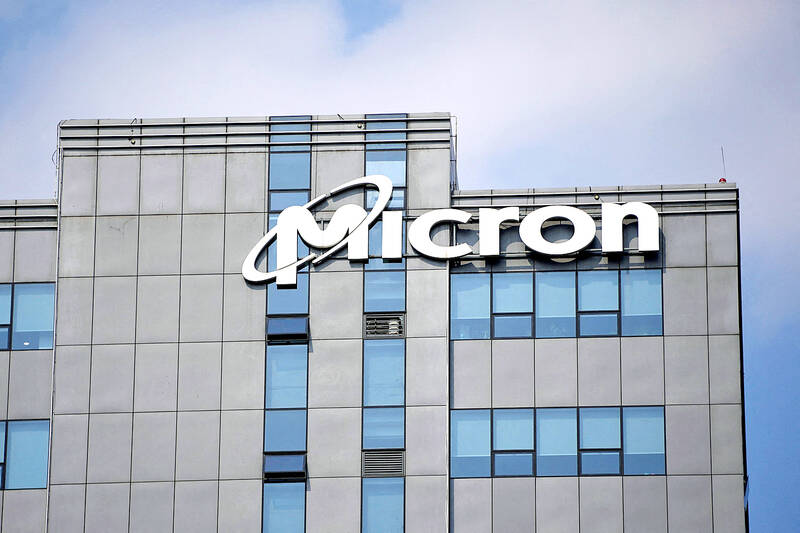Micron Technology Inc on Wednesday predicted a steeper loss than anticipated in the current quarter, indicating that an industry slump is still weighing on the largest US maker of memory chips.
The company projected a fiscal first-quarter loss of as much as US$1.14 a share, excluding some items. Analysts had estimated a US$0.96 loss. On the bright side, revenue is expected to start recovering in the period. Micron predicted sales of US$4.2 billion to US$4.6 billion, compared with an estimate of US$4.21 billion.
For Micron and competitors Samsung Electronics Co and SK Hynix Inc, this year has been brutal. Customers in their main markets — PCs and smartphones — have slashed orders as they cope with lackluster demand and stockpiles of excess parts.

Photo: Reuters
Micron CEO Sanjay Mehrotra said the firm has taken “decisive actions on supply and cost,” which would help the company as the market for memory chips recovers next year and then reaches record levels again in 2025.
The burden of excess inventory has now lifted and Micron’s customers, apart from those who make data center servers, are ordering at levels that reflect demand for their products, Mehrotra said in an interview. In some areas, devices makers are now increasing the amount of memory and storage put into each product.
Prices for Micron’s products are going up, and the rate of the price jump is increasing, he said.
“This is how we’ll enter 2024,” Mehrotra added.
The company’s latest forecast suggests sales would begin to grow again in the fiscal first quarter, which runs through November.
Yet one additional obstacle that Micron faces is Beijing’s designation of its products as a security risk. That has already cut into the US company’s revenue in China — the largest market for semiconductors — in what management has previously called a “significant headwind.”
Micron expects the industry outlook to brighten considerably by 2025 — especially as artificial intelligence systems demand new types of more expensive memory chips.
In the interim, the outlook remains mixed. In traditional servers — the computers that are still the mainstay of most data centers — demand remains “lackluster,” Mehrotra said.
Personal computers and smartphones should return to growth next year, with units increasing by a percentage in the low to mid-single digits, Micron said.
To cope with the slowdown, Micron and its peers reined in production, severely reducing supply and helping prices bottom out. It expects to be “significantly” below peak output last year for the foreseeable future.
The company plans to continue to run factories at less than full capacity well into next year. Micron would also further reduce spending on new equipment next year.

TECH BOOST: New TSMC wafer fabs in Arizona are to dramatically improve US advanced chip production, a report by market research firm TrendForce said With Taiwan Semiconductor Manufacturing Co (TSMC, 台積電) pouring large funds into Arizona, the US is expected to see an improvement in its status to become the second-largest maker of advanced semiconductors in 2027, Taipei-based market researcher TrendForce Corp (集邦科技) said in a report last week. TrendForce estimates the US would account for a 21 percent share in the global advanced integrated circuit (IC) production market by 2027, sharply up from the current 9 percent, as TSMC is investing US$65 billion to build three wafer fabs in Arizona, the report said. TrendForce defined the advanced chipmaking processes as the 7-nanometer process or more

Who would not want a social media audience that grows without new content? During the three years she paused production of her short do-it-yourself (DIY) farmer’s lifestyle videos, Chinese vlogger Li Ziqi (李子柒), 34, has seen her YouTube subscribers increase to 20.2 million from about 14 million. While YouTube is banned in China, her fan base there — although not the size of YouTube’s MrBeast, who has 330 million subscribers — is close to 100 million across the country’s social media platforms Douyin (抖音), Sina Weibo (新浪微博) and Xiaohongshu (小紅書). When Li finally released new videos last week — ending what has

OPEN SCIENCE: International collaboration on math and science will persevere even if the incoming Trump administration imposes strict controls, Nvidia’s CEO said Nvidia Corp CEO Jensen Huang (黃仁勳) said on Saturday that global cooperation in technology would continue even if the incoming US administration imposes stricter export controls on advanced computing products. US president-elect Donald Trump, in his first term in office, imposed restrictions on the sale of US technology to China citing national security — a policy continued under US President Joe Biden. The curbs forced Nvidia, the world’s leading maker of chips used for artificial intelligence (AI) applications, to change its product lineup in China. The US chipmaking giant last week reported record-high quarterly revenue on the back of strong AI chip

Qualcomm Inc’s interest in pursuing an acquisition of Intel Corp has cooled, people familiar with the matter said, upending what would have likely been one of the largest technology deals of all time. The complexities associated with acquiring all of Intel has made a deal less attractive to Qualcomm, said some of the people, asking not to be identified discussing confidential matters. It is always possible Qualcomm looks at pieces of Intel instead or rekindles its interest later, they added. Representatives for Qualcomm and Intel declined to comment. Qualcomm made a preliminary approach to Intel on a possible takeover, Bloomberg News and other media